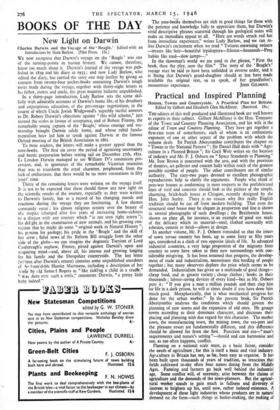Practical and Inspired Planning
THE editors of this well produced and illustrated book are well known as experts in their subject. Gilbert McAllister is the Hon. Treasurer of the Town and Country Planning Association, and his wife is the editor of Town and Country Planning. They have got together a first-rate team of contributors, each of whom is an enthusiastic exponent of one or other -aspect of the problem with which the volume deals. Sir Patrick Abercrombie contributes the chapter on " Towns in the National Pattern " ; Sir Daniel Hall deals with " Agri- culture in a Planned Britain "; Sir Cecil Weir writes on the location of industry and Mr. F. J. Osborn on " Space Standards in Planning." Mr. Ivor Brown is concerned with the arts, and with the provision of theatres, art galleries and concert halls within reach of the greatest possible number of people. The other contributors are of similar authority. The sixty-two pages devoted to excellent photographic reproductions help to clarify the arguments. People who think of post-war houses as conforming in most respects to the prefabricated lines of steel and concrete should look at the picture of the simple. charming, brick-built house at Claygate, recently designed by the Hon. John Seeley. There is no reason why this really English tradition should be cut off from modern building. That even the structural steel house may be elegant in proportion and line is shown in several photographs of such dwellings ; the Braithwaite house, shown on plate 48, for instance, is an example of good use made of the delicacy which its material—steel, clothed outwardly with asbestos, cement or brick—allows in design.
In another volume, Mr. F. J. Osborn reminded us that the issues of town versus country has been, up to some forty or fifty years ago, considered as a clash of two opposite ideals of life. In advanced industrial countries, a very large proportion of the migrants from country to town have taken to their new surroundings with con- siderable misgiving. It has been assumed that progress, the develop- ment of trade and industrialism, necessitates this herding of people together; many observers deplore the price which seems to be demandd. Industrialism has given us a multitude of good things— cheap food, and in greater variety ; cheap clothes ; books in their thousands ; labour-saving devices of every kind—but as Mr. Osborn puts it : " If you give a man a million pounds and then clap him for life in a dark prison, he will at times doubt if you have done him much good. Metaphorically, that is what mechanical progress has done for the urban worker." In the present book, Sir Patrick Abercrombie analyses the conditions which should govern the planning of new towns and the expansion of old ones. He groups towns according to their dominant character, and discusses their placing and planning with due regard for this character. The market town, the manufacturing town, the mining town, the sea-port and the pleasure resort are fundamentally different, and this difference should be allowed for from the first. Function and site—" man's requirements and nature's setting "—should and can harmonise and not, as too often happens, conflict.
Planning on a national scale must, as a basic factor, consider the needs of agriculture ; for this is itself a basic and vital industry. Agriculture in Britain has not, so far, been easy to organise. It has been built upon thousands of years of tradition, so tenacious that fields cultivated to-day often bear names dating from the Middle Ages. Farming and farmers go back well behind the industrial age. Some conflict will, of necessity, arise between the claims of agriculture and the demands of the town-planners. But the agricul- tural worker stands to gain much in fullness and diversity of interest to brighten up his, until now, rather isolated existence. A development of those light industries whose products are in natural demand on the farm—such things as basket-making, the making of tight farm implements, harness-making and mending, cider-making, :emit-canning and bottling and many others—might offer a variety employment to village folk not actually working on the land. With these, proper housing at rents within the means of the farm worker, and access to at any rate some of the amenities enjoyed by he town-dweller, the depopulation of the countryside should at least 'pe checked.
If the family is to remain the unit in planning either houses or flats, the necessity for growth must be taken into account. One of the chief drawbacks of individual ownership of the home is that a house which is just right for a newly-married couple is very much ynisfit for that same couple with their family in twelve years' time. In thirty years, with the children married and gone, it may again be appropriate. Insufficient and unsuitable housing conditions are :he cause of a large number of deliberately childless marriages ; and :he childless marriage is both socially and biologically undesirable. in town-planning, therefore, houses of different size and capacity ihould be provided in the same neighbourhood, so that exchanges night easily be made to suit differing demands, without necessitating removal from friends, familiar shops and habitual surroundings.
HARRY ROBERTS.



























 Previous page
Previous page